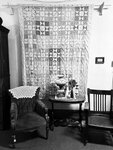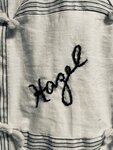





“We become neighbors when we’re willing to cross the road for one another.” The Dutch writer, Henri Nouwen, might just as well have been specifically talking
about the Eagle Valley Homemakers Club organized in 1932. If you’re local you
know that Eagle Valley is the neighborhood which sent their children to District 10 Country School. Roughly, it’s a part of the countryside east and north of West Concord.
Homemakers Clubs in Minnesota came about through the University of Minnesota. In 1889 the University hired its first woman instructional staff person. She began to travel rural Minnesota and teach residents bread making and other food preparation skills. She also taught sewing of clothing, poultry raising, child development, and health matters. By 1917 there were 1100 Minnesota Homemakers Clubs. They were founded to improve the lives of their members, but brought women together socially and gave them the chance to be leaders. Eventually all the counties in Minnesota hired Home Demonstration Agents to work with the rural clubs.
What a joy it is that the Museum was given the Eagle Valley Club’s secretary’s notebook for the years 1932-1937. I was more than thankful for the beautiful cursive writing of the secretaries as I poured through six years of minutes.
The Eagle Valley Club had a few rules. Members should be from the School District 10 area, but charter members were exempted if they weren’t precisely from that area. Women could stay members if they moved, just as long as they were no more than 3 miles away. All new members should have at least 3 chances to join the club, including one written invitation. Meetings would be once a month on the third Wednesday, beginning at 1:30 p.m. and ending at 4:30 p.m. Dues were decided to be 25 cents a year, plus a Penny March each month.
The idea of a Penny March was new to me, but I learned that churches and other groups had been collecting coins for orphans in children’s homes in the early 1900s and calling them Penny Marches. Between church service and Sunday School children would march by the collection container, put in their coins, and learn about giving to others. Eagle Valley’s version of the Penny March was to collect coins, save them, and use them to help buy gifts, cards, and flowers for ill and bereaved members and extended family. It was the heart of the depression and Penny Marches contributed 9 to 17 cents each month, about $2.00 in today’s money. Bridal and baby showers were added gracious gatherings that the club gave its members and families.
Specifications for the lunch following each meeting were included in the constitution. Lunch was to contain 3 items and coffee. Cheese and pickles were designated to be one of the 3 items. That made me smile. Dinners to include spouses and the whole family would take place in January, February and March. Members would help furnish the dinners and were divided into East and West neighborhood groups to make things more convenient. The winter was a less busy time for the farmers and they enjoyed the winter diversions the Club planned. Refreshment, serving, dishwashing and entertainment committees were formed to facilitate the dinners.
Many of the members of the club in the 30’s are names we are familiar with today: Josephine Andrews, Delia Cain, Audrey Cornwell, Ora Gochnauer, Julia Hanson, Hazel Jones, Dena Mensing, Rose Noser, Molly Osborn, Beatrice Rauchenstein, Dorothy Saxer, Hilda Sykes, Alyce Trelstad, Joy Urch, Ethel Van Allen. Ida and Ruth Wright, and Louise Zeller are the names listed on the 1935 membership roster.
In the summer of 1932 members and their families enjoyed a moonlight picnic supper at their June meeting. Their next meeting was a picnic lunch on Gochnauer’s lawn. The club decided that 20 cents should be given by each member to leaders who were going to teach classes at meetings, to help pay for materials needed, etc. Sewing lessons were taught about cutting out and making children’s garments, as well as how to create smocking. Table crafts and etiquette were offered, too. A meeting in August had an unusually low attendance due to canning, threshing, and the Dodge County Fair.
That was a very busy time, to be sure.
As the club ventured on they developed a closer relationship with their neighborhood school. They decided that their giving of sympathy and congratulatory cards should be extended to District 10’s teacher and her family and that they should invite her to be a member. They held a program at the schoolhouse and served lunch at a charge of 10 cents for adults and 5 cents for kids. They also decided they should help pay for the new curtains to be hung at the school,
I am so impressed by the energy and dedication of the Eagle Valley homemakers who made quilt after quilt, crocheted rug after crocheted rug, embroidered luncheon cloths and towels, and spent months of meetings making cookbooks. Money from the treasury bought oilcloth and paper for the cookbooks and each member brought two 7” x 10” pieces of cardboard for the project. How I wish we could see one of those cookbooks! (Is there one “out there” somewhere?)
Quilts and crocheted rugs, which were all cooperative projects of the group, were often raffled off on dinner nights. The men could put their names in the drawing, too, for 5 cents each. You need to come to the Museum and see two of the quilts made by the Eagle Valley Club. Their names were embroidered into the quilts and are such an integral part of the Club’s History. They’re hanging on the walls in our first floor hallway, just waiting for you.
Parties at holiday times were part of the Club’s year. The description of 1937’s Halloween party is particularly poignant. “Our entertaining committee gave us a perfect party, made so by their diligence and labor. We will remember our Oct., 1937 party as a day of laughter. Next, as usual, followed our neighborly chat while touching elbow to elbow, partaking of the lunch served by Julia.”
I know exactly what she meant because our homemakers club, The Jolly Neighbors, still meets and I wouldn’t trade the warmth and hospitality I’ve been shown by my neighbors at our gatherings. Through the years West Concord has enjoyed many homemaker clubs, from N.I.S. to South Star Club. If you have anything you’d like to share about any of them, please contact us at the Museum. The clubs are such a lovely piece of West Concord’s history.